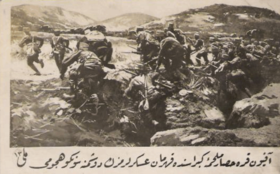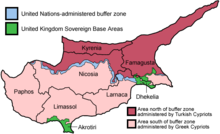- Military history of Turkey
-
For other uses, see Military history of Turkey (disambiguation).
The military history of Turkey is the history of modern Armed forces established under Republic of Turkey beginning with the Turkish War of Independence.
 History of the
History of the
Republic of TurkeyIndependence · Republic 1919–1923 1923–1946 1946–present Economic · Constitutional · Military Contents
War of Independence
The Turkish revolutionaries rejected the Treaty of Sèvres (1920), which had left the Ottoman government in control of substantially less of Anatolia than modern Turkey controls. Following the victory of Atatürk's forces in the War of Independence, the Treaty of Sèvres was substituted with the Treaty of Lausanne (1923), which granted international recognition to the government of Ankara, rather than the Ottoman government in Istanbul.
World War II
World War II broke out in the first year of the İsmet İnönü presidency, and both the Allies and the Axis started to put pressure on Inönü to bring Turkey into the war on their respective sides. The Germans sent Franz von Papen to Ankara, while Winston Churchill secretly met with Inönü inside a train wagon near Adana on January 30, 1943. Inönü later met with Franklin D. Roosevelt and Winston Churchill at the Second Cairo Conference on December 4–6, 1943. Turkey remained neutral until the final stages of World War II and tried to maintain an equal distance between both the Axis and the Allies until February 1945, when Turkey entered the war on the side of the Allies against Germany and Japan.
Until 1941, both Roosevelt and Churchill thought that continued Turkish neutrality would serve the interests of the Allies by blocking the Axis from reaching the strategic oil reserves of the Middle East. But the early victories of the Axis up to the end of 1942 caused Roosevelt and Churchill to re-evaluate a possible Turkish participation in the war on the side of the Allies. Turkey had maintained a decently-sized Army and Air Force throughout the war, and Churchill wanted the Turks to open a new front in the Balkans. Roosevelt, on the other hand, still believed that a Turkish attack would be too risky, and an eventual Turkish failure would have disastrous effects for the Allies. Inönü knew very well the hardships which his country had suffered during 11 years of incessant war between 1911 and 1922 and was determined to keep Turkey out of another war as long as he could. Inönü also wanted assurances on financial and military aid for Turkey, as well as a guarantee that the United States and the United Kingdom would stand beside Turkey in case of a Soviet invasion of the Turkish Straits after the war.
Korean War
Main article: Turkish BrigadeDuring the Cold War, Turkey participated in the Korean War as a member state of the United Nations, suffering 731 deaths in combat. The fear of a Soviet invasion and Stalin's unconcealed desire to control the Turkish Straits eventually led Turkey to give up its principle of neutrality in foreign relations and join NATO on February 18, 1952. Following NATO membership the Turkey initiated a comprehensive modernization program for its Armed Forces.
Cyprus
See also: Military operations during the Invasion of Cyprus (1974)In July 1974, the Turkish Armed Forces intervened against a coup in Cyprus, organized by EOKA-B and led by Nikos Sampson who ousted the democratically elected Cypriot President Archbishop Makarios III in order to establish Enosis (Union) between Greece and Cyprus. The coup was backed by the Greek military junta in Athens. On 20 July 1974 the Turkish Army invaded the island from the north, landing in Pente Mili beach, near Keryneia. The operations (named Attila I and II) lasted until August and resulted in 37% of Cyprus territory coming under Turkish military control[1]. Turkey still maintains troops in Cyprus, since a political solution could not yet be achieved, and since many members of the Turkish Cypriot community fear a return to the intercommunal violence which occurred between 1963 and 1974[2].
Recent
Towards the end of the 1980s, a restructuring and modernization process has been initiated by the Turkish Armed Forces, which still continues today. The final goal of Turkey is to produce indigenous military equipment and to become increasingly self-sufficient in terms of military technologies.
2011 Libyan Uprising
Turkey's armed forces participated in the NATO-led military intervention and no-fly zone in Libya against Muammar Gaddafi's government troops.
The Turkish Navy participated with five ships and one submarine in the NATO-led naval blockade to enforce the arms embargo. It additionally provided six F-16 Fighting Falcon jets for aerial operations. On 24 March 2011, Turkey's parliament approved Turkish participation in military operations in Libya, including enforcing the NFZ in Libya. The airbases committed were Incirlik and İzmir.
See also
- Turkish Military
- Military of the Ottoman Empire
References
- ^ http://en.wikipedia.org/wiki/Military_operations_during_the_Invasion_of_Cyprus_(1974)
- ^ Cyprus Intercommunal Violence
External links
- (Turkish) Official Turkish Navy website
- (Turkish) Official Turkish Armed Forces website
- Turkish Naval Museum
- Turkish Navy
- Turkey in the First World War
Links to related articles Military history of Europe Sovereign
states- Albania
- Andorra
- Armenia
- Austria
- Azerbaijan
- Belarus
- Belgium
- Bosnia and Herzegovina
- Bulgaria
- Croatia
- Cyprus
- Czech Republic
- Denmark
- Estonia
- Finland
- France
- Georgia
- Germany
- Greece
- Hungary
- Iceland
- Ireland
- Italy
- Kazakhstan
- Latvia
- Liechtenstein
- Lithuania
- Luxembourg
- Macedonia
- Malta
- Moldova
- Monaco
- Montenegro
- Netherlands
- Norway
- Poland
- Portugal
- Romania
- Russia
- San Marino
- Serbia
- Slovakia
- Slovenia
- Spain
- Sweden
- Switzerland
- Turkey
- Ukraine
- United Kingdom
States with limited
recognition- Abkhazia
- Kosovo
- Nagorno-Karabakh
- Northern Cyprus
- South Ossetia
- Transnistria
Other entities Military history of Asia Sovereign
states- Afghanistan
- Armenia
- Azerbaijan
- Bahrain
- Bangladesh
- Bhutan
- Brunei
- Burma (Myanmar)
- Cambodia
- People's Republic of China
- Cyprus
- East Timor (Timor-Leste)
- Egypt
- Georgia
- India
- Indonesia
- Iran
- Iraq
- Israel
- Japan
- Jordan
- Kazakhstan
- North Korea
- South Korea
- Kuwait
- Kyrgyzstan
- Laos
- Lebanon
- Malaysia
- Maldives
- Mongolia
- Nepal
- Oman
- Pakistan
- Philippines
- Qatar
- Russia
- Saudi Arabia
- Singapore
- Sri Lanka
- Syria
- Tajikistan
- Thailand
- Turkey
- Turkmenistan
- United Arab Emirates
- Uzbekistan
- Vietnam
- Yemen
States with limited
recognition- Abkhazia
- Nagorno-Karabakh
- Northern Cyprus
- Palestine
- Republic of China (Taiwan)
- South Ossetia
Dependencies and
other territories- Christmas Island
- Cocos (Keeling) Islands
- Hong Kong
- Macau
Categories:
Wikimedia Foundation. 2010.



